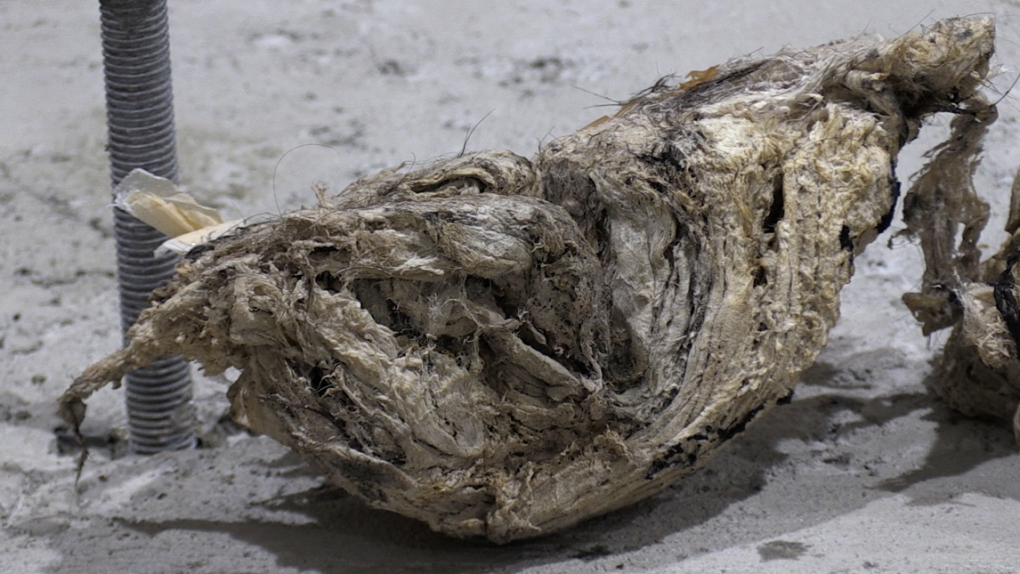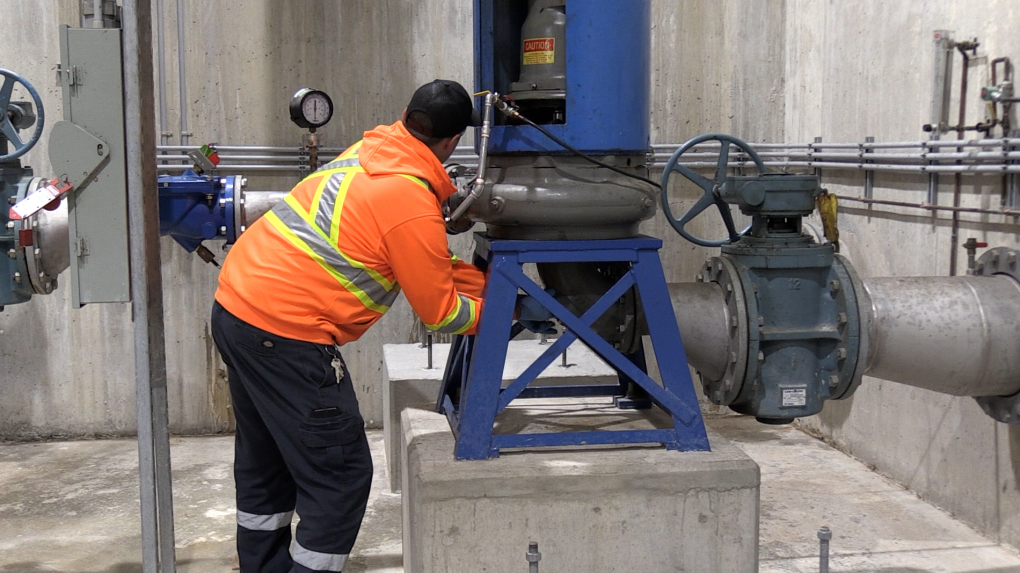How sewage wads are impacting the City of Kitchener's sewers
The City of Kitchener wants residents to make sure they're flushing the right things down the drain.
All too often wads of garbage flushed down the toilet end up blocking the sewer pumps.
“We see plastic bags, I've seen t-shirts, underwear, feminine products, lots of hair,” Justin Szusz, a sewer maintainer for pumping stations with the City of Kitchener said.
“This has been an ongoing issue, and it's no better or worse. It's just consistent. We're really trying to get the message out there to only put down the drain what belongs down there,” Nick Gollan, manager of Utility Planning and Programs, Sanitary and Stormwater for the City of Kitchener, said.
 A wad of garbage found in a city sewer pump at the Woolner Pumping Station in Kitchener is seen on Oct. 16, 2024. (Colton Wiens/CTV News)
A wad of garbage found in a city sewer pump at the Woolner Pumping Station in Kitchener is seen on Oct. 16, 2024. (Colton Wiens/CTV News)
There are 834 kilometres of sewage pipes in the city that flow to 23 various pumping stations. When residents flush or drain something, it travels through sewers and collects at the pumping stations. It’s then pumped uphill to a gravity sewer and drained to the wastewater treatment plant. Gollan said unclogging those pumps is a timely issue.
“Some of the main challenges that we have is the blockages of these pumps, which take two hours, several times per week to clean out. We also have 300 locations across the city where we get grease buildup, and that needs to be flushed out using specialized equipment in order to keep the sewers flowing freely,” Gollan said. “If these blockages aren't dealt with and addressed the sewer stop flowing, this can cause basement flooding and toilets backing up. So, it's really important not to flush inappropriate things into the sanitary system.”
The two main problem areas that often contribute to sewer issues are when residents pour grease down the kitchen drain and when the wrong thing is flushed down the toilet.
 Justin Szusz opens a sewer pump at the Woolner Pumping Station in Kitchener on Oct. 16, 2024. (Colton Wiens/CTV News)
Justin Szusz opens a sewer pump at the Woolner Pumping Station in Kitchener on Oct. 16, 2024. (Colton Wiens/CTV News)
How can you help?
The city said use a strainer in the kitchen sink and collect grease with a paper towel. When flushing the toilet, follow the three P's: only flush pee, poop and (toilet) paper.
“Flushable wipes do not break down when they're flowing through the sewer system. They're too robust. Toilet paper is really the only thing, the material falls apart in the sewer and doesn't cause any blockages,” Gollan said.
“Just don't flush your wipes and use your three P’s,” Szusz said.
It’s timely guidance, as the city has approved a comprehensive sanitary master plan looking at the entire sewer system and the impact on the city’s planned growth.
“What we don't know is the condition of 75 per cent of our trunk sewers and the force mains that leave these pumping stations. We'll be putting a lot of effort into collecting that information over the next year or two and determining what sort of investment needs to be made in the system to ensure that it keeps functioning properly,” Gollan said. “We could be looking at an additional 100,000 toilets in the city over the next 25 to 30 years. We need to plan for that and make sure the system is prepared to take on that additional flow.”
CTVNews.ca Top Stories

Possible scenarios that could play out in Ottawa as the Liberal government teeters
Prime Minister Justin Trudeau is said to be reflecting on his future over the holidays after the resignation of his top cabinet minister, Chrystia Freeland, in mid-December. The bombshell move prompted a fresh wave of calls for Trudeau to step down as Liberal leader from inside and outside the caucus.
LIVE UPDATES Latest info: FBI says the New Orleans truck attacker acted alone in an 'act of terrorism'
The FBI now says the New Orleans truck attacker acted alone in an 'act of terrorism' when he drove a pickup truck into a crowd of New Year's revellers early Wednesday, killing 14 people.
Woman, father killed on New Year's Eve were victims of intimate partner violence: Halifax police
Halifax police are investigating three deaths that are connected – two of which they say were homicides resulting from intimate partner violence – in the city on New Year’s Eve.
Man who died in Tesla Cybertruck explosion was active-duty U.S. Army soldier, officials say
The person who authorities believe died in the explosion of a Tesla Cybertruck packed with firework mortars and camp fuel canisters outside U.S. president-elect Donald Trump's Las Vegas hotel was an active-duty U.S. Army soldier, three U.S. officials told The Associated Press on Thursday.
FORECAST Weather warnings issued in 6 provinces and territories
Wintry weather conditions, including heavy snow and wind chill values around -55, prompted warnings in six provinces and territories early Thursday morning.
Sask. RCMP locate missing inmate of Yorkton prison
An inmate who was wanted for being unlawfully-at-large after not returning to Whitespruce Provincial Training Centre in Yorkton has been found and arrested.
5 things we know and still don't know about COVID, 5 years after it appeared
The virus is still with us, though humanity has built up immunity through vaccinations and infections. It's less deadly than it was in the pandemic's early days and it no longer tops the list of leading causes of death. But the virus is evolving, meaning scientists must track it closely.
Who are Canada's top-earning CEOs and how much do they make?
Canada's 100 highest-paid CEOs earned $13.2 million on average in 2023 from salaries, bonuses and other compensation, according to the Canadian Centre for Policy Alternatives.
More Popsicles, please: Your tonsils can grow back
Tonsil regrowth is rare. Here's one woman's experience when she had to get her tonsils removed – again.

































